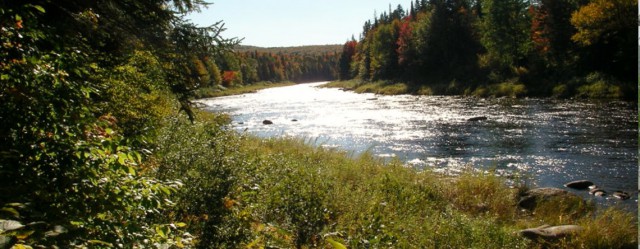Conservation Council Press Release
For Immediate Release
Fredericton – On Friday, August 15, the New Brunswick Ombudsman, Charles Murray, tabled a report on his investigation into Department of Environment’s management of the Water Classification Program. The Report provides damning evidence in support of the complaint, indicating that successive ministers have been intentional in their inaction to classify 19 rivers as intended under the regulation for the past 12 years.
The investigation was prompted by a complaint to the office of the Ombudsman in February 2013 by the Nashwaak Watershed Association and supporters, including the Conservation Council of New Brunswick.
The Ombudsman, whose office has a mandate to investigate complaints of unfair administration of government legislations and policies, lays out the history of the Water Classification Program, communication evidence from government and stakeholders, and how the Department has discharged its responsibilities in delivering the Program and enforcing the regulation. In highlight, the Report:
- Outlines the very active role the Department played in setting up the program, including the regulation development, training modules, and direct funding from the Environmental Trust Fund to undertake the necessary field work and documentation to proceed with classification.
- Points out that not a single river has been classified under the program even though 19 applications have been received since 2003 and that the Department has not communicated that they will not be.
- Implicates the Department of Environment, particularly the ministerial leadership over the past 12 years, as having “perpetuated the illusion that the province has a water classification program”, as having “allowed the problem to exist by deflecting public pressure”, and having misused ministerial discretion to “render null” the entire program.
- Is appreciative of the role that watershed groups have played over the years in fostering relationships with the Department, their volunteer hours in producing the mandatory requirements for classification, and exhausting all avenues for seeking clarity on the inaction.
- Is critical of the Department’s credibility and ability to work with citizen groups, witnessing through communications, the “decay of trust and goodwill between these citizens and their government.”
- Concludes that the Water Classification Program and accompanying regulation is “illusionary”, “a mirage”, akin to “a smoke detector without batteries”, “misleading to observers”, and “provides no protection.”
Conservation Council response to the Ombudsman’s Report
CCNB was encouraged to see the Ombudsman’s office follow through with the complaint which was supported by the Conservation Council in February of 2013.
Particularly:
- We are proud of the work we have done, with NWAI and others, to bring the Department’s inaction on its own law to the public. We will continue to work to make sure this action will lead to measurable results to fix the ineffectiveness of the Water Classification Regulation.
- We applaud the Nashwaak Watershed Association, who after 10 years of working to have their river classified as per the expectations of the program and good faith from the Department, decided to take the next step in forcing the examination of the program’s failure. The Report is a result of their determination to seek a fair resolution in their efforts to protect the Nashwaak River.
- We continue to be deeply concerned that New Brunswick’s water protection policies are faltering and grossly inadequate to meet the pressures of planned resource extraction industries. New clearcutting and river buffer infringement from the new Forestry Management Plan, shale gas exploration and development, mining proposals such as Sisson Mine in the headwaters of the Nashwaak River watershed all present threats to New Brunswick’s waterways and it is clear from the Ombudsman’s report that our strongest tool to protect them is ineffective, nonexistent.
- CCNB will be in contact with the Department of Environment to request a meeting to learn about their detailed plan to address the Ombudsman’s findings and recommendations.
About the Water Classification Program
The Water Classification Program and regulation was brought forth in 2002 as a progressive intention to set water quality standards in New Brunswick rivers and generate action plans to meet and enhance their protection.
The regulation, which is still in effect, allows for community-based organizations, financially supported by the Department of Environment, to collect water samples, analyze the quality of the water as A, B, and C (based on standards for drinking water, protection of aquatic life, further degradation of the water) and set goals for the maintenance or enhancement of that water quality. The goals are set by the watershed organizations with input from the wider watershed community and the Department of Environment. The classifications and goals were to be set in legal protection under the Clean Water Act and any development activity that would impact that water quality was to seek consultation with the community to downgrade the water quality. Otherwise, development projects would be required by law to respect the classification of the river system.
In its 2002 guide to the regulation the Department said the Water Classification Regulation establishes a “bottom line” management goal for the water quality of all classified waters in the Province.
When passed in 2002, the Department of Environment said the intent of the regulation was to “eventually classify all waters in the Province, watershed by watershed.”
Nineteen organizations representing 19 watersheds/river systems are directly impacted by the failure of this program and regulation, including:
Cap-Pelé area watersheds
Westerly watersheds of Caraquet Bay
Chaleur Bay Watersheds (Jacquet, Belledune, Nigadoo, Elmstree, Little Elmtree, and Millstream rivers, Armstrong, Duncan, Guitard, Fournier and Henry Brooks)
Bay of Fundy watersheds composite
Hammond River
Kennebecasis River
Kent County Watersheds (Chockpish, Bouctouche & Cocagne Rivers)
Kouchibouguac River and Black River Composite, Kouchibouguacis River
Madawaska River
Meduxnekeag River
Miramichi River
Nashwaak River
Petitcodiac River and Memramcook River
Pokemouche River
Richibucto River
Shediac and Scoudouc Rivers
St. Croix River
Tabusintac River
Big and Little Tracadie Rivers
Media Contacts:
Stephanie Merrill, Freshwater Protection Program, Conservation Council of New Brunswick
(o) 506.458.8747; (c) 506.261.8317; water@conservationcouncil.ca
Paul McLaughlin, President, Nashwaak Watershed Association
(h) 506.450.4943; (c) 506.440.3625; blindfaithstudio@gmail.com

